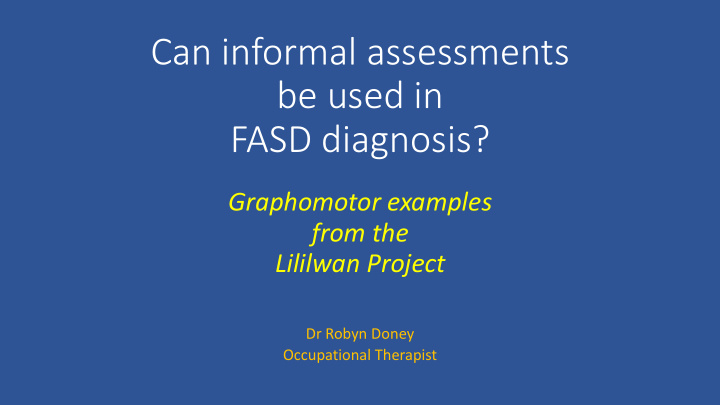



Can informal assessments be used in FASD diagnosis? Graphomotor examples from the Lililwan Project Dr Robyn Doney Occupational Therapist
The Lililwan Project Aims Methods Findings Significance Background
The Lililwan Project Stage 2 • Multidisciplinary May - October 2011 n = 108 assessment ➢ Paediatrician ➢ Speech pathologist ➔ ➢ Psychologist ➢ Occupational therapist ➢ Physiotherapist ➢ Audiologist ➢ Opthalmologist Aims Methods Findings Significance Background 4
Neurodevelopmental Impairment 1. Soft neurological signs a) Fine motor skills b) Gross motor skills c) Visual-motor integration d) Visual perception e) Sensory function f) Articulation g) Phonology h) Motor speech Background Aims Methods Findings Significance
Methods • Handwriting • Drawing Informal assessments • Fine motor skills • Visual-motor integration Formal • Sensory processing assessments Background Aims Methods Findings Significance
Assessment Tool: BOT2 Fine Motor Composite Fine Manual Manual Control Coordination Fine Motor Fine Motor Manual Upper-Limb Precision Integration Dexterity Coordination Background Aims Methods Findings Significance
Bruininks-OseretskyT est of Motor Proficiency: Fine Motor Skills 60 No PAE PAE, no FASD FASD 50 Standard score 40 30 Fine Motor Fine Manual Control Manual Coordination FASD < No Composite FASD < No PAE PAE p < .05 Robyn Doney p < .05
Assessment Tool: Beery VMI Background Aims Methods Findings Significance
Beery-Buktenica Developmental T est of Visual-Motor Integration 100 95 90 85 80 75 70 Visual-Motor Visual Perception Motor Coordination Integration FASD < No PAE No PAE PAE, no FASD FASD p < .05 Robyn Doney
Assessment Tool: Sensory Profile Background Aims Methods Findings Significance
Informal Assessments Drawing Sentence Name of self Background Aims Methods Findings Significance
Informal Assessments: Observations Core Concentration strength Following Sensory Pencil grasp instructions issues Tremor Handedness Sitting Writing Vision posture pressure BUILDING RAPPORT Background Aims Methods Findings Significance
Informal Assessments: Analysis Evaluation T ool of Children’s Handwriting Miller Function and Participation Scales (ETCH) (M-Fun) Background Aims Methods Findings Significance
Handwriting Results 85 80 75 70 65 60 55 50 45 Name: Letter Sentence: Letter Sentence: Word legibility legibility legibility No PAE PAE, no FASD FASD Background Aims Methods Findings Significance
Drawing Results 14 12 10 8 6 4 Body awareness Motor accuracy Total score No PAE PAE, no FASD FASD Background Aims Methods Findings Significance
Sentences No prenatal alcohol exposure (No-PAE) Prenatal Alcohol Exposure (PAE) Background Aims Methods Findings Significance
Sentences No PAE PAE Background Aims Methods Findings Significance
Sentences No PAE PAE
Drawings PAE No PAE Background Aims Methods Findings Significance
Drawings No PAE PAE Background Aims Methods Findings Significance
Drawings No PAE PAE Background Aims Methods Findings Significance
Drawings No PAE PAE Background Aims Methods Findings Significance
Drawings No PAE PAE Background Aims Methods Findings Significance
Background Aims Methods Findings Significance
Conclusions CLINICAL REASONING Background Aims Methods Findings Significance
Thankyou ☺
Recommend
More recommend